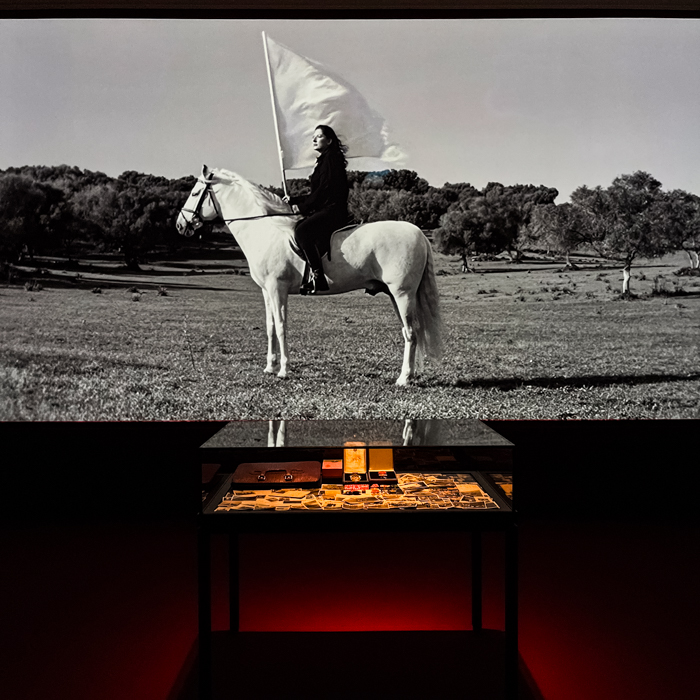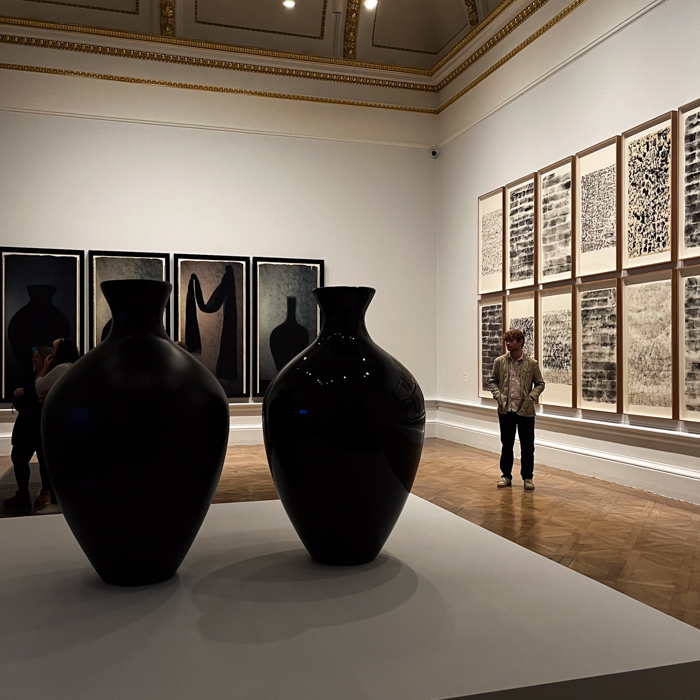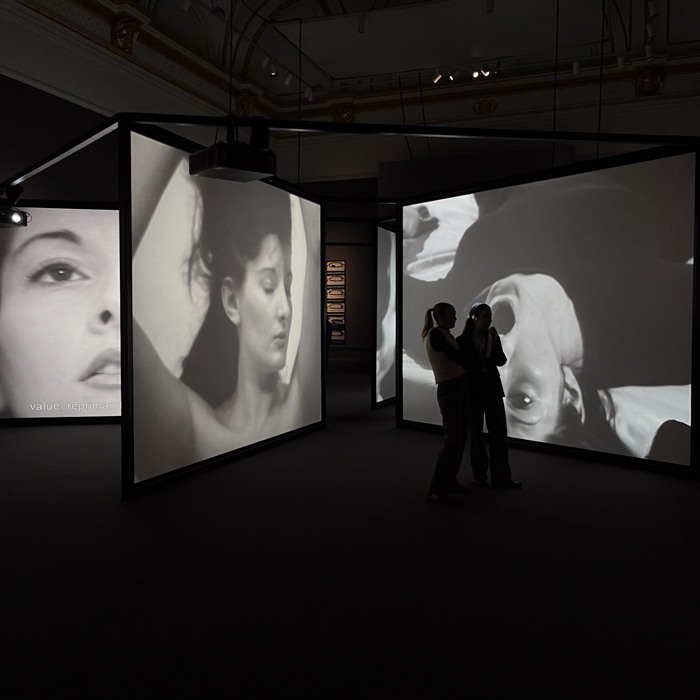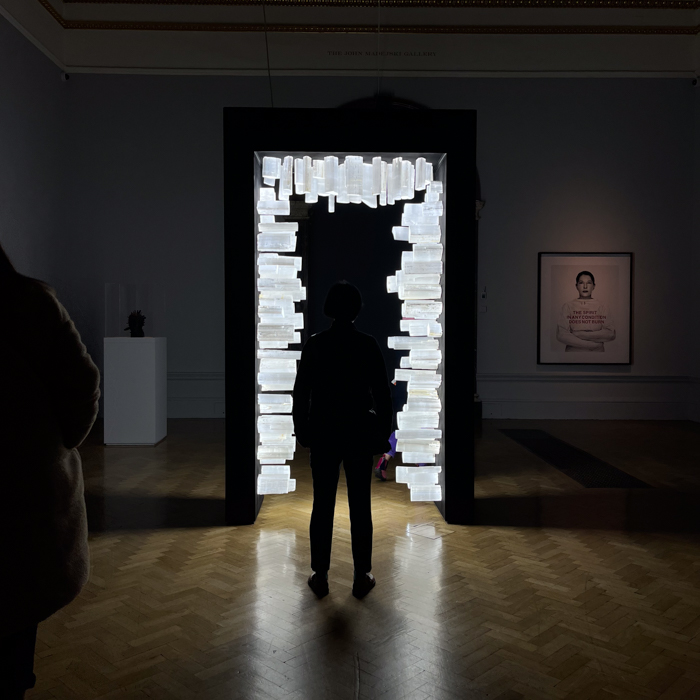Modern art is full of determined characters. The ones who find success are visionary, changing the face of the contemporary art scene. Marina Abramović‘s exhibition at the Royal Academy marks the first retrospective of a female artist in the institution’s 255 years. The exhibition is one of the largest, occupying the academy’s previously unused rooms. While it was initially planned for September 2020, due to Covid-19 it was postponed numerous times. During this period Abramović suffered an embolism which prevented her from performing in the show as initially planned. It’s an unfortunate reality for an artist who is usually so generous with herself as a performer.
Throughout her career, Abramović has dealt with the enormous themes of Life, Death, Memory, Love and Sex. In this retrospective, no stone is left unturned. Far from the stale exhibitions often on show at the RA, Abramović’s entices with a mix of live performances, instillation and archive video. Like her, this show is determined to make you feel. In this exhibition, footage from her 50-year career is combined with four live reenactments: Impoderabillia (1977), Nude with Skeleton (2002), Luminosity (1997), and The House with the Ocean View (2002). Each reenactment is staged by performers trained in the Abramović method, a technique inspired by the art of Tadeusz Kantor and the direction of Jerzy Grotowski. These four performances were pivotal in the progression of Abramović’s career. Although other works like Rhythm 0 (1974) and Rest Energy (1980), displayed in video format, were also hugely influential.
A majority of the exhibition is displayed on video screens, and the ephemerality of Abramović’s artwork lends itself well to this method. Of course, the pieces lose the immediate effect of live performance, but that is to be expected. Much of Abramović’s earlier work has her partaking in Dangerous tasks like blasting her face into unconsciousness or holding a loaded gun to her head, for obvious reasons, these would be difficult to safely reenact.
Of the footage on display, one of the large first room’s is dedicated to Rythm 0. This performance garnered Abramović the ear of the art scene and the distrust of many outside of it. In 1974, an incensed Abramović staged a show in Naples that challenged its audience to treat her like an object. She was commenting on their refusal to accept her work as real art. What began as an innocent interaction soon escalated to loaded guns and knives being pressed to the artist’s neck. This footage is projected behind a banquet table draped in white, the artefacts from the performance in 1974 are arranged neatly atop. The objects, ranging from saws to guns to feather boas, have an eerie spirit about them frankly lying across the crisp white tablecloth.
The first live encounter is Impoderabillia, or the naked doorway. It wasn’t surprising to see that it created the same tension as it did in the late 70s. Out of the dozens of visitors during my time at the exhibition, in defeat, most chose to pass through the much more enticing empty doorway. After a few laps of the show, I, on the other hand, removed my bag and took the plunge! The last live performance is The House with the Ocean View (2002), and it drew the largest crowd. Maybe because it was featured in Sex and the City? This 12-day-long production consists of a performer, dressed in Abramović red, housed in a Brutalist dollhouse consisting of three rooms: a bedroom, dining room and bathroom. Going about her tasks she often gazes down through sleepy lids at the audience below. The performance feels like a glimpse into purgatory.
A somewhat less impressive part of the show is The Era of Crystals, her current phase. This part of the exhibition is interactive and fills the latter end of the exhibition. From the copper tubs filled with camomile to crystal ‘shoes of departure’, this part of the show feels a bit like entering a Day spa ‘apothecary’ on King’s Road. To my surprise, I wasn’t offered an herbal tea when lying on the crystal embalming table. Portal, is the crowning glory, a 300 cm tall arch adorned with selenite crystals. Intending to symbolise transition, it feels a little too Instagramable to have much depth. This era is certainly not the raw Abramović we’re accustomed to, it presents Abramović as the self-indulgent ‘Bourgois Bohemian’ we all hope she has not become. These crystalline works provide a stark, and somewhat disappointing, contrast with the dangerous feats of her early days.
Abramović has acquired a kind of celebrity status. And, to those who are used to the average RA show, it can appear that her work is overly self-indulgent. When faced with her most recent work this title is understandable. However, for the majority of her career, Abramović’s work was neither self-indulgent nor esoteric. It expressed a desire to rid herself of material confines and is an expression in the rawest sense of the word. Marina Abramović at the Royal Academy proves her depth as an artist goes far beyond her newfound celebrity status. Perhaps her absence marks a change in the status quo of her work. As an artist who once gave her body to the audience, she describes her trajectory as ‘more and more of less and less’.
Abramović has made her life her art, so while she is absent from this encounter, ‘The Artist is present’ in this 50-year retrospective.
– J. Gataaura
Photos by Art Observed courtesy of J. Gataaura








